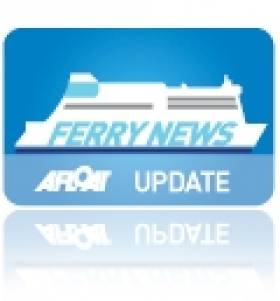Displaying items by tag: Stena Contract Expired
#BackToFront- Dun Laoghaire Harbour Company's public consultation process over a €18m Cruise-Berth ended yesterday and came in advance of Stena Line's contract with the harbour authority that expired today, writes Jehan Ashmore.
Following the closure of public submissions on the cruise plan which drew controversary, DLHC are to lodge a finalised planning application to An Bord Pleanala. The application will be accompanied by an (EIS) Environmental Impact Statement for the proposed berth regarded as a Strategic Infrastructure.
The cruise berth capable of handling some of the world's largest cruiseships, formed part of the DLHC Masterplan adopted in 2011 and in the knowledge of the declining Stena Line ferry operations.
The plan for a new 435m jetty in the centre of the harbour with associate 300m cruise quay is to accommodate massive cruiseships that are even larger than those calling at anchorage.
This seasons first caller, notably the 333m long MSC Splendida of 137,000 tonnes is due on 11 May with 3,600 passengers and 1,300 crew. The cruiseship's crew total is 200 short of those taken on the HSS 1500 series Stena Explorer.
An announcement by the ferry operator last February that is was to withdraw operating the seasonal-only Dun Laoghaire-Holyhead route permanently in 2015.
Stena citing unsustainable losses and concentrated on their existing use of Dublin Port services to Holyhead served by last month's newcomer Superfast X alongside Stena Adventurer. The Dublin Port Company's proposed €30 cruise terminal near the East-Link bridge was unveiled recently at the Miami Exhibition, Florida.
In regards to the final HSS Stena Explorer sailing (see Ships Monthly photo) on Dun Laoghaire-Holyhead route this took place last September. A subsequent stint of sailings to cover the Festive and New Year sailings were cancelled on the historic Ireland-Wales link.
At Dun Laoghaire the specialist ro-ro-linkspan structure is exclusively designed for use of HSS Stena Explorer. As previously reported, as part of the Stena contract with DLHC there are plans underway by subsidaries of the ferry company to remove the HSS related structure from St. Michaels Wharf.
As part of the proposed cruise-berth plan, the St. Michaels Wharf ferry terminal's vehicle marshalling area are to be used for cruise-ship related traffic in the form of coaches and taxis. In addition is the construction of a boardwalk overlooking the adjoining 820-boat marina.
The HSS ferry terminal completed in the mid-1990's stands on the site of a former car-ferry terminal dating to the 1960's and is from where ferries may return. As previously reported, an invitation from DLHC was sought from suitable providers to resume the Ireland-Wales route with submissions due by February.
DLHC required that such a ferry operator would re-open the route on a seasonal-only basis, in which seven parties expressed an interest. Should such operations begin, DLHC have stated this would not be until 2016.























